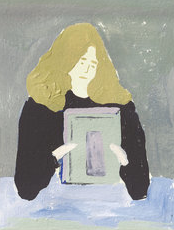The latest non-fiction essay by Joans Marans Dim, “My Husband’s Things”, is an intimate look into the grieving author’s struggle to accept the death of her husband, Stuart. Published in The New York Times last Wednesday, Dim’s essay chronicles the surreal experience of digging through Stuart’s things after he passed away from Cancer in June 2013, leaving her a widow.
Dim’s tone is quiet and reflective, unfolding in its sentimentality as Dim begins the process of digging through Stuart’s things. She sorts through desk papers and hoards of never-worn jackets; piles of jeans and a collection of stopwatches that have suddenly become a mass of perverse relics. We feel Dim’s emotional fatigue translated through the objects overwhelming her, as though Tim O’Brien took his hand at cataloguing “the things carried” by a grieving widow:
There are many suits from his work years, untouched in a decade. A navy blue cashmere topcoat never worn. Much too formal. A tweed sport jacket purchased years ago on an extravagant visit to Harrods in London. Also, multiple warm coats and jackets from L.L. Bean and Eddie Bauer. Perhaps 30 pairs of shoes and so many socks — thick and rough hiking socks from his mountain climbing days, cotton socks from his running days, woolen ones and argyles from his working days.
With him gone, our papers are no longer properly filed. In fact, my new filing system is an empty box from the grocery store. I find it, at least temporarily, an efficient arrangement, because every paper that passes through my hands is now located in one spot. Nevertheless, such slippage by me would be sinful to Stuart, who kept detailed records on almost every item he touched. But then, I rationalize, in the filing department I have always been a disappointment.
Every item harkens back to another time, tugging Dim between nostalgia, longing and grief. She struggles to accept Stuart’s death; it’s as if the moment she feels settled in the slightest serenity, she’ll glance at one of his old coats and begin wallowing in doubt and self-deprecation.
Dim finds a poem from Stuart, written in the days when the two were students at New York University in the 1960s:
Think in the morn
There will be no sorrow.
Think what is today
Is not tomorrow.
It is an anachronistic object that takes on almost magical liberties in its ability to comfort Dim. Stuart may be physically gone, but his words become a tangible anchor of support for her.
Then there are the computer messages: friendly reminders Stuart scheduled, before his passing, to complete everyday tasks. The first comes weeks after his death, reminding Dim to “Please water the blueberry bushes.”
Today, when a loved one passes we are reminded of their absence in almost every aspect of our lives, physical or otherwise – particularly when we consider how technologically dependent we are in our everyday routines. Accepting a death while grieving can feel like a ceaseless, unmapped task for a widow like Dim. But this is precisely the point: there are layers to our grief.
There is a duality that deepens our sadness and sustains a love and appreciation for the one we’ve lost.
Related Articles:
- Coping with Death: Pierre Berge and a Life in Objects
- Reflecting on Joan Didion’s The Year of Magical Thinking
- What is the Art of the Dying? An Interview with Diedre Scherer

 Messages from Beyond Death: “My Husband’s Things”
Messages from Beyond Death: “My Husband’s Things”






 “As Tears Go By” by Marianne Faithfull
“As Tears Go By” by Marianne Faithfull
 “The Sea” by John Banville
“The Sea” by John Banville














